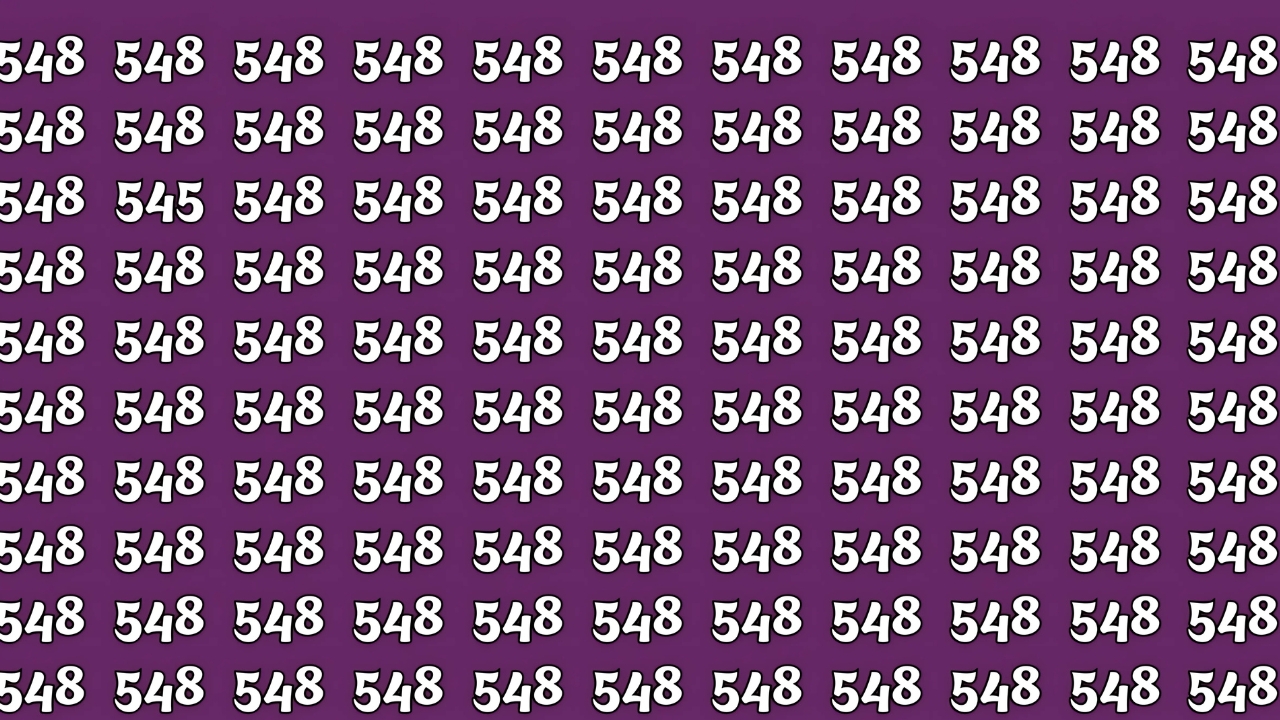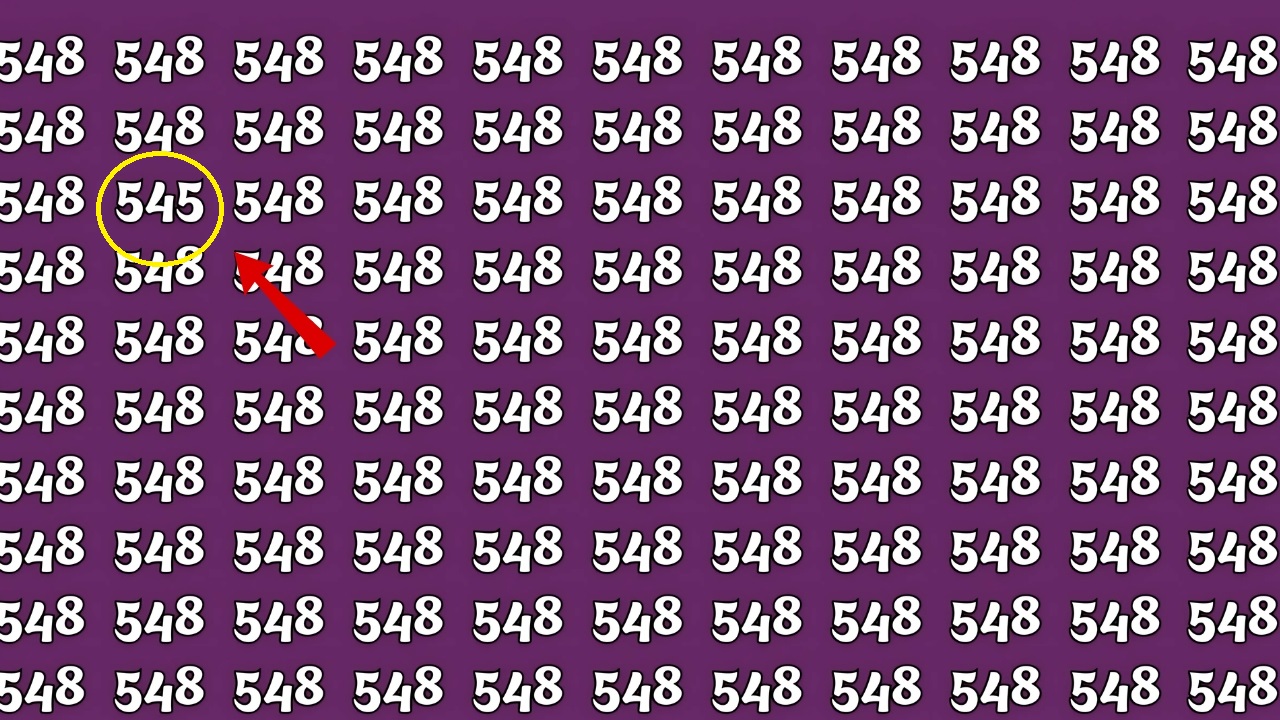Optical Illusion Challenges Number 545 : The human brain processes visual information with remarkable speed and complexity, yet it can be surprisingly easy to fool.
Optical illusions and visual brain teasers have captivated people for centuries, revealing the fascinating ways our minds interpret the world around us. Among these challenges, number-finding puzzles have emerged as particularly engaging tests of visual attention and pattern recognition.
The challenge to find the number 545 hidden within a complex visual field represents just one example of how these deceptively simple puzzles can reveal the intricate workings of human perception.
Understanding the Science Behind Visual Perception
Before diving into the specific challenge of finding hidden numbers, it’s essential to understand how our visual system processes information. The human eye doesn’t simply record images like a camera.
Instead, it works in conjunction with the brain to actively construct our visual experience through a complex process of interpretation and prediction.

When light enters the eye, it strikes the retina, where specialized cells called photoreceptors convert light energy into electrical signals. These signals travel through the optic nerve to various regions of the brain, where they undergo extensive processing.
The visual cortex, located in the occipital lobe, plays a crucial role in organizing and interpreting these signals, helping us recognize shapes, patterns, colors, and movement.
This processing system has evolved to be incredibly efficient at identifying important information quickly. However, this efficiency comes with trade-offs.
Our brains use shortcuts and assumptions to process visual information rapidly, which can sometimes lead to misinterpretations or missed details. This is precisely what makes optical illusions and hidden number challenges so effective at challenging our perception.
The Psychology of Attention and Pattern Recognition
The ability to find hidden numbers like 545 in a complex visual field relies heavily on two key cognitive processes: selective attention and pattern recognition.
Selective attention allows us to focus on specific aspects of our visual environment while filtering out irrelevant information. This mechanism is essential for navigating a world filled with overwhelming amounts of visual stimuli.
Pattern recognition, meanwhile, enables us to identify familiar shapes, forms, and configurations based on our past experiences and learned associations.
When searching for the number 545, your brain attempts to match the visual pattern of these digits against the background noise of the puzzle.
The challenge becomes particularly interesting when designers deliberately manipulate these processes. They might use similar fonts, colors, or orientations to camouflage the target number, forcing your brain to work harder to distinguish the relevant information from the distracting elements.
This creates what psychologists call a “visual search task,” where the difficulty depends on the similarity between the target and the distractors.
Types of Number-Finding Challenges
Visual puzzles that ask you to find hidden numbers come in various forms, each presenting unique challenges to your perceptual system. Understanding these different types can help you develop more effective strategies for solving them.
Grid-based puzzles present numbers arranged in rows and columns, often with the target number camouflaged among similar-looking digits or symbols. These challenges test your ability to systematically scan visual information while maintaining focus on the specific pattern you’re seeking.
Font variation puzzles use different typefaces, sizes, or orientations to hide the target number. The number 545 might appear in a different font style, rotated at an angle, or scaled differently from the surrounding elements. These puzzles challenge your ability to recognize numerical patterns despite changes in their visual presentation.
Color camouflage puzzles use color similarities or contrasts to hide numbers within complex backgrounds. The target number might be presented in a slightly different shade that’s difficult to distinguish from the background, requiring careful attention to subtle color variations.
Overlapping element puzzles present numbers that intersect or overlap with other visual elements, making it necessary to mentally separate the target from the surrounding clutter. These challenges test your ability to use gestalt principles to group visual elements appropriately.
Cognitive Benefits of Visual Brain Teasers
Engaging with optical illusions and number-finding challenges offers several cognitive benefits that extend beyond mere entertainment. These activities function as mental exercises that can help maintain and improve various aspects of cognitive function.
Visual attention training occurs naturally when you practice these puzzles regularly. The process of systematically searching for hidden elements helps strengthen your ability to focus and sustain attention over time. This skill transfers to many real-world activities, from reading and studying to driving and workplace tasks that require sustained visual attention.
Pattern recognition enhancement develops through repeated exposure to different types of visual challenges. As you encounter various hiding strategies and camouflage techniques, your brain becomes better at quickly identifying relevant patterns and distinguishing them from irrelevant background information.
Processing speed improvements can result from regular practice with timed challenges like the 10-second brain teaser. The pressure to find the target quickly encourages your brain to develop more efficient search strategies and faster recognition processes.
Working memory strengthening occurs as you hold the target pattern in mind while scanning through complex visual fields. This ability to maintain and manipulate information in short-term memory is crucial for many cognitive tasks and can be improved through practice.
Strategies for Solving Hidden Number Puzzles
Developing effective strategies can significantly improve your performance on number-finding challenges. These approaches work by optimizing how you deploy your visual attention and process the available information.
The systematic scanning approach involves methodically examining the puzzle from left to right, top to bottom, or in another organized pattern. This strategy helps ensure that you don’t miss any areas and can be particularly effective for grid-based puzzles. However, it requires patience and can be time-consuming for complex images.
The pattern breakdown strategy involves analyzing the target number by its component parts. For the number 545, you might first search for the distinctive shape of the “5” or look for the vertical line of the “4.” This approach can be faster than searching for the complete number, especially when the digits are partially obscured or overlapping.
The peripheral vision technique takes advantage of the fact that our peripheral vision is particularly sensitive to movement and unusual patterns. By relaxing your focus and allowing your eyes to take in the entire puzzle at once, you might notice the target number through subtle differences in contrast or alignment.
The color filtering method involves mentally filtering out certain colors or focusing on specific color ranges. If you notice that most distracting elements share certain color properties, you can train your attention to focus primarily on elements that don’t match these characteristics.
The Role of Individual Differences
Not everyone approaches visual puzzles in the same way, and individual differences in cognitive abilities and perceptual preferences can significantly affect performance on these challenges. Understanding these variations can help explain why some people excel at finding hidden numbers while others struggle with the same tasks.
Visual processing speed varies considerably among individuals, with some people naturally able to process visual information more quickly than others. This difference can be influenced by factors including age, education, and experience with similar tasks. Regular practice with visual puzzles can help improve processing speed over time.
Attention span and focus abilities also play crucial roles in puzzle-solving success. People with better sustained attention abilities tend to perform better on challenging visual search tasks, while those who are easily distracted may struggle to maintain focus long enough to find hidden elements.
Spatial reasoning skills contribute to success with puzzles that involve rotated, scaled, or otherwise transformed numbers. Individuals with stronger spatial abilities may find it easier to recognize target patterns despite changes in orientation or size.
Color vision differences can significantly impact performance on puzzles that rely on color-based camouflage. People with color vision deficiencies might find certain puzzles more challenging, while others might actually have advantages in detecting patterns that rely on brightness rather than color contrasts.
Creating Effective Visual Challenges
Understanding what makes a good optical illusion or number-finding puzzle requires insight into the balance between difficulty and solvability. The most engaging challenges are those that feel difficult enough to be satisfying when solved, but not so impossible that they become frustrating.
Appropriate difficulty scaling involves carefully controlling the factors that contribute to puzzle difficulty. These might include the number of distracting elements, the similarity between the target and distractors, the size relationships, and the color contrasts involved. Effective puzzles gradually increase in difficulty to provide a sense of progression and achievement.
Visual hierarchy management helps ensure that the hidden element is discoverable through careful observation while remaining sufficiently camouflaged to present a genuine challenge. This often involves subtle manipulations of contrast, size, and positioning that make the target slightly different from its surroundings without making it immediately obvious.
Time pressure considerations recognize that adding time constraints can dramatically change the nature of a visual challenge. A 10-second time limit transforms a methodical search task into a rapid pattern recognition challenge, requiring different cognitive strategies and creating a more intense, engaging experience.
The Future of Visual Perception Challenges
As our understanding of visual perception and cognitive processing continues to advance, new types of optical illusions and brain teasers continue to emerge. Technology now allows for the creation of dynamic, interactive puzzles that can adapt to individual skill levels and provide personalized challenges.
Adaptive difficulty systems can monitor your performance and automatically adjust puzzle parameters to maintain an optimal level of challenge. These systems might track how quickly you find hidden elements and modify future puzzles to ensure they remain engaging without becoming overwhelming.
Virtual and augmented reality platforms offer new possibilities for creating immersive visual challenges that extend beyond traditional two-dimensional puzzles. These technologies can create three-dimensional hiding places and use spatial relationships in ways that weren’t previously possible.
Neurological research continues to reveal new insights into how our brains process visual information, leading to more sophisticated understanding of what makes certain visual challenges more difficult or engaging than others. This research may eventually lead to puzzles specifically designed to exercise particular aspects of visual processing.
Optical Illusion Answer

The simple challenge of finding the number 545 hidden in a visual puzzle represents a fascinating intersection of neuroscience, psychology, and entertainment. These brain teasers reveal the remarkable complexity of human visual perception while providing engaging mental exercise that can help maintain and improve cognitive function.
Whether you solve the puzzle in the allotted 10 seconds or need more time to locate the hidden number, the process itself offers valuable insights into how your mind processes visual information. The strategies you develop, the individual differences you discover, and the improvements you experience through practice all contribute to a deeper understanding of your own cognitive abilities.
As you continue to engage with optical illusions and visual brain teasers, remember that the real value lies not just in finding the hidden elements, but in understanding the fascinating processes that make such challenges possible. Each puzzle solved is both an achievement and a small window into the remarkable capabilities of the human mind.

